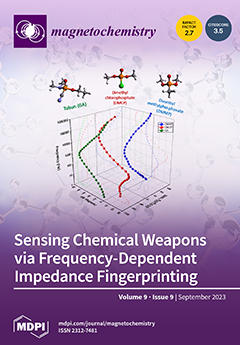We investigated the magnetic properties of the antiferromagnetic (AFM) topological insulator MnBi
Te
with a partial substitution of Mn atoms by non-magnetic elements (A
= Ge, Pb, Sn). Samples with various element concentrations (10–80%) were studied using SQUID magnetometry. The
[...] Read more.
We investigated the magnetic properties of the antiferromagnetic (AFM) topological insulator MnBi
Te
with a partial substitution of Mn atoms by non-magnetic elements (A
= Ge, Pb, Sn). Samples with various element concentrations (10–80%) were studied using SQUID magnetometry. The results demonstrate that, for all substitutes the type of magnetic ordering remains AFM, while the Néel temperature (T
) and spin-flop transition field (H
) decrease with an increasing A
= Ge, Pb, Sn concentration. The rate of decrease varies among the elements, being highest for Pb, followed by Sn and Ge. This behavior is attributed to the combined effects of the magnetic dilution and lattice parameter increase on magnetic properties, most prominent in (Mn
Pb
)Bi
Te
. Besides this, the linear approximation of the experimental data of T
and H
suggests higher magnetic parameters for pure MnBi
Te
than observed experimentally, indicating the possibility of their non-monotonic variation at low concentrations and the potential for enhancing magnetic properties through doping MnBi
Te
with small amounts of nonmagnetic impurities. Notably, the (Mn
Pb
)Bi
Te
sample with 10% Pb substitution indeed exhibits increased magnetic parameters, which is also validated by local-probe analyses using ARPES. Our findings shed light on tailoring the magnetic behavior of MnBi
Te
-based materials, offering insights into the potential applications in device technologies.
Full article





